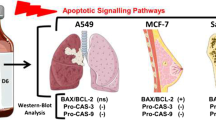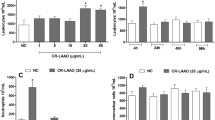Abstract
We report the elucidation of a mechanism of apoptosis induction in breast cancer (MCF-7) cells by an l-amino acid oxidase (LAAO), Rusvinoxidase, purified from the venom of Daboia russelii russelii. Peptide mass fingerprinting analysis of Rusvinoxidase, an acidic monomeric glycoprotein with a mass of ~57 kDa, confirmed its identity as snake venom LAAO. The enzymatic activity of Rusvinoxidase was completely abolished after two cycles of freezing and thawing; however, its cytotoxicity toward MCF-7 cells remained unaffected. Dose- and time-dependent induction of apoptosis by Rusvinoxidase on MCF-7 cells was evident from changes in cell morphology, cell membrane integrity, shrinkage of cells and apoptotic body formation accompanied by DNA fragmentation. Rusvinoxidase induced apoptosis in MCF-7 cells by both the extrinsic (death-receptor) and intrinsic (mitochondrial) signaling pathways. The former pathway of apoptosis operated through activation of caspase-8 that subsequently activated caspase-7 but not caspase-3. Rusvinoxidase-induced intrinsic pathway of apoptosis was accompanied by a time-dependent depolarization of the mitochondrial membrane through the generation of reactive oxygen species, followed by a decrease in cellular glutathione content and catalase activity, and down-regulation of expression of anti-apoptotic proteins Bcl-XL and heat-shock proteins (HSP-90 and HSP-70). Rusvinoxidase treatment resulted in increase of the pro-apoptotic protein Bax, subsequently leading to the release of cytochrome c from mitochondria to the cytosol and activating caspase-9, which in turn stimulated effector caspase-7. Rusvinoxidase at a dose of 4 mg/kg was non-toxic in mice, indicating that it may be useful as a model for the development of peptide-based anticancer drugs.









Similar content being viewed by others
References
World Health Organization (2012) GLOBOCAN 2012: estimated cancer incidence, mortality and prevalence worldwide in 2012. http://globocan.iarc.fr/Default.aspx
Takacs Z, Nathan S (2014) Animal venoms in medicine. In: Wexler P (ed) Encyclopedia of toxicology, 3rd edn. Elsevier, London, pp 252–259
Ellmore S (2007) Apoptosis: a review of programmed cell death. Toxicol Pathol 35:495–516
Mukherjee AK, Saikia D, Thakur R (2011) Medical and diagnostic application of snake venom proteomes. J Proteins Proteomics 21:31–40
Costa TR, Burin SM, Menaldo DL, de Castro FA, Sampaio SV (2014) Snake venom l-amino acid oxidases: an overview on their antitumor effects. J Venom Anim Toxins Incl Trop Dis 20:23
Guo C, Liu S, Yao Y, Zhang Q, Sun MZ (2012) Past decade study of snake venom l-amino acid oxidase. Toxicon 60:302–311
Naumann GB, Silva LF, Silva l, Faria G, Richardson M, Evangelista K, Kohlhoff M, Gontijo CM, Navdaev A, de Rezende FF, Eble JA, Sanchez EF (2011) Cytotoxicity and inhibition of platelet aggregation caused by an l-amino acid oxidase from Bothrops leucurus venom. Biochim Biophys Acta 1810:683–694
Mandal S, Bhattacharyya D (2008) Two l-amino acid oxidase isoenzymes from Russell’s viper (Daboia russelli russelli) venom with different mechanisms of inhibition by substrate analogs. FEBS J 275:2078–2095
Mukherjee AK, Mackessy SP (2013) Biochemical and pharmacological properties of a new thrombin-like serine protease (Russelobin) from the venom of Russell’s viper (Daboia russelii russelii) and assessment of its therapeutic potential. Biochim Biophys Acta-General Subj 1830:3476–3488
Mukherjee AK, Mackessy SP, Dutta S (2014) Characterization of a Kunitz-type protease inhibitor peptide (Rusvikunin) purified from Daboia russelii russelii venom. Int J Biol Macromol 67:154–162
Weissbach H, Robertson AV, Witkop B, Udenfriend S (1961) Rapid spectrophotometric assays for snake venom l-amino acid oxidase based on the oxidation of l-kynurenine or 3,4-dehydro-l-proline. Anal Biochem 1:286–290
Aird SD, da Silva NJ Jr (1991) Comparative enzymatic composition of Brazilian coral snake (Micrurus) venoms. Comp Biochem Physiol 99B:287–294
Costa FLS, Rodrigues RS, Izidoro LFM, Menaldo DL, Hamaguchi A, Homsi-Brandeburgo MI, Fuly AL, Soares SG, Selistre-de-Araújo HS, Barraviera B, Soares AM, Rodrigues VM (2009) Biochemical and functional properties of a thrombin-like enzyme isolated from Bothrops pauloensis snake venom. Toxicon 54:725–735
Rutkowski RB (1996) Human plasma and serum trypsin-like esterase activity. Clin Chem 12:350–356
Mukherjee AK, Mackessy SP (2014) Pharmacological properties and pathophysiological significance of a Kunitz-type protease inhibitor (Rusvikunin-II) and its protein complex (Rusvikunin complex) purified from Daboia russelii russelii venom. Toxicon 89:55–66
Ioannou YA, Chen FW (1997) Quantitation of DNA fragmentation in apoptosis. Nucl. Acids Res. 24:992–993
Herrmann M, Lorenz HM, Voll R, Griinke M, Woith W, Kalden JR (1994) A rapid and simple method for the isolation of apoptotic DNA fragments. Nucl Acids Res. 22:5506–5550
Nigam M, Ranjan V, Srivastava S, Sharma R, Balapure AK (2008) Centchroman induces G0/G1 arrest and caspase-dependent apoptosis involving mitochondrial membrane depolarization in MCF-7 and MDA MB-231 human breast cancer cells. Life Sci 82:577–590
Zargan J, Umar S, Sajad M, Naime M, Ali S, Khan HA (2011) Scorpion venom (Odonto buthusdoriae) induces apoptosis by depolarization of mitochondria and reduces S-phase population in human breast cancer cells (MCF-7). Toxicol In Vitro 25:1748–1756
McGee MM, Hyland E, Campiani G, Ramunno A, Nacci V, Zisterer DM (2002) Caspase-3 is not essential for DNA fragmentation in MCF-7 cells during apoptosis induced by the pyrrolo-1,5-benzoxazepine, PBOX-6. FEBS Lett 515:66–70
Samel M, Tonismagi K, Ronnholm G, Vija H, Siigur J, Kalkkinen N, Siigur E (2008) l-Amino acid oxidase from Naja naja oxiana venom. Comp Biochem Physiol B 149:572–580
Torii S, Naito M, Tsuruo T (1997) Apoxin I, a novel apoptosis-inducing factor with l-amino acid oxidase activity purified from Western diamondback rattlesnake venom. J Biol Chem 272:9539–9542
Ande SR, Kommoju PR, Draxl S, Murkovic M, Macheroux P, Ghisla S, Ferrando-May E (2006) Mechanisms of cell death induction by l-amino acid oxidase, a major component of ophidian venom. Apoptosis 11:1439–1451
Alves RM, Antonucci GA, Paiva HH, Cintra AC, Franco JJ, Mendonca-Franqueiro EP, Dorta DJ, Giglio JR, Rosa JC, Fuly AL, Dias BM, Soares AM, Sampaio SV (2008) Evidence of caspase-mediated apoptosis induced by l-amino acid oxidase isolated from Bothrops atrox snake venom. Comp Biochem Physiol A 151:542–550
Burin SM, Ayres LR, Neves RP, Ambrósio L, de Morais FR, Dias-Baruffi M, Sampaio SV, Pereira-Crott LS, de Castro FA (2013) l-Amino acid oxidase isolated from Bothrops pirajai induces apoptosis in BCR-ABL-positive cells and potentiates imatinibmesylate effect. Basic Clin Pharmacol Toxicol 113:103–112
Wagner BA, Evig CB, Reszka KJ, Buettner GR, Burns CP (2005) Doxorubicin increases intracellular hydrogen peroxide in PC3 prostate cancer cells. Arch Biochem Biophys 440:181–190
Riss TL, Moravec RL (2004) Use of multiple assay endpoints to investigate the effects of incubation time, dose of toxin, and plating density in cell-based cytotoxicity assays. Assay Drug Dev Technol 2:51–62
Tassone P, Tagliaferri P, Prricelli A, Blotta S, Quaresima B, Martelli ML, Goel A, Barbieri V, Costanzo F, Boland CR, Venuta S (2003) BRCA expression modulates chemosensitivity of BRCA1-defective HCC1937 human breast cancer cells. Br J Cancer 88:1285–1291
Fornari FA, Randolph JK, Yalowich JC, Ritke MK, Gewirtz DA (1994) Interference by doxorubicin with DNA unwinding in MCF-7 breast tumor cells. Mol Pharmacol 45:649–656
Seeger H, Huober J, Wallwiener D, Mueck AO (2004) Inhibition of human breast cancer cell proliferation with estradiol metabolites is as effective as with tamoxifen. Horm Metab Res 36:277–280
Boatright KM, Salvesen GS (2003) Mechanisms of caspase activation. Curr Opin Cell Biol 15:725–731
Ashkenazi A, Dixit VM (1998) Death receptors: signaling and modulation. Science 281:1305–1308
Dıáz GD, Li Q, Roderick RH (2003) Caspase-8 and apoptosis-inducing factor mediate a cytochrome c-independent pathway of apoptosis in human colon cancer cells induced by the dietary phytochemical chlorophyllin. Cancer Res 63:1254–1261
Liang Y, Yan C, Schor NF (2001) Apoptosis in the absence of caspase 3. Oncogene 20:6570–6578
Circu ML, Aw TY (2010) Reactive oxygen species, cellular redox systems, and apoptosis. Free Radic Biol Med 48:749–762
Pan M-H, Huang Y-T, Ho C-T, Chang C-I, Hsu P-C, Pan BS (2006) Induction of apoptosis by Meretrix lusoria through reactive oxygen species production, glutathione depletion, and caspase activation in human leukemia cells. Life Sci 79:1140–1152
Franco R, Cidlowski JA (2009) Apoptosis and glutathione: beyond an antioxidant. Cell Death Differ 16:1303–1314
Valdameria G, Trombetta-Limab M, Worfel PR, Pires ARA, Martinez GR, Noleto GR, Cadena SMSC, Sogayar MC, Winnischofer SMB, Rocha MEM (2011) Involvement of catalase in the apoptotic mechanism induced by apigenin in HepG2 human hepatoma cells. Chem Biol Interact 193:180–189
Backos DS, FranklinCC Reigan P (2012) The role of glutathione in brain tumor drug resistance. Biochem Pharmacol 83:1005–1012
Akman SA, Forrest G, Chu FF, Doroshow JH (1989) Resistance to hydrogen peroxide associated with altered catalase mRNA stability in MCF7 breast cancer cells. Biochim Biophys Acta 1009:70–74
Piwocka K, Jaruga E, Skierski J, Gradzka I, Sikora E (2001) Effect of glutathione depletion on caspase-3 independent apoptosis pathway induced by curcumin in Jurkat cells. Free Radic Biol Med 31:670–678
Barbosa IA, Machad NG, Machad AJ, Scott PM, Oliveira PJ (2012) Mitochondrial remodeling in cancer metabolism and survival: potential for new therapies. Biochim Biophys Acta 1826:238–254
Salakou S, Kardamakis D, Tsamandas AC, Zolota V, Apostolakis E, Tzelepi V, Papathanasopoulos P, Bonikos DS, Papapetropoulos T, Petsas T, Dougenis D (2007) Increased Bax/Bcl-2 ratio up-regulates caspase-3 and increases apoptosis in the thymus of patients with myasthenia gravis. In Vivo 1:123–132
Gupta SD, Gomes A, Debnath A, Saha A, Gomes A (2010) Apoptosis induction in human leukemic cells by a novel protein Bengalin, isolated from Indian black scorpion venom: through mitochondrial pathway and inhibition of heat shock proteins. Chem Biol Interact 183:293–303
Sreedhar AS, Csermely P (2004) Heat shock proteins in the regulation of apoptosis: new strategies in tumor therapy. A comprehensive review. Pharmacol Ther 101:227–257
Acknowledgments
Authors thank Dr. R. Mukhopadhyay, TU for HEK cell cytotoxicity assay. AKM is the recipient of DBT-Crest award from the Department of Biotechnology, Ministry of Science and Technology, Govt. of India, which supported his participation in this study. Support was also provided by a BioScience Discovery award from COEDIT (to SPM).
Author information
Authors and Affiliations
Corresponding author
Electronic supplementary material
Below is the link to the electronic supplementary material.
10495_2015_1157_MOESM1_ESM.tif
Supplementary material 1 Fig. S1. Fractionation of crude D. r. russelii venom (200 mg) on size-exclusion BioGel P-100 column (2.8×80 cm). Fractionation was done with 25 mM HEPES buffer containing 100 mM NaCl, 5 mM CaCl2 (pH 6.8) at a flow rate of 6 ml/h. Protein elution was monitored at 280 nm. Elution of Rusvinoxidase from gel-filtration column is indicated with an arrow. [This supplementary figure was originally published as Figure 1A by Mukherjee and Mackessy, 2013 (reference 3) and is reproduced with permission from Biochim. Biophys. Acta] (TIFF 56 kb)
10495_2015_1157_MOESM2_ESM.tif
Supplementary material 2 Fig. S2. FPLC cation exchange fractionation of Bio-Gel peak 1 (supplementary Fig. S1) using a Tricorn Mono Q 5/50 GL column. After eluting the non-specifically bound proteins of Bio-Gel peak 1 with buffer A (20 mM Tris-HCl, pH 8.0), bound proteins were eluted with a linear gradient of 350 mM NaCl in buffer A at a flow rate of 45 ml/h. Elution of proteins was monitored at 280 nm and 0.75 ml fractions were collected. Elution of Rusvinoxidase is indicated by an arrow in the FPLC chromatogram. [This supplementary figure was originally published as Figure 1 by Mukherjee et al, Thrombosis Research 134 (2014), 1150–1156] (TIFF 71 kb)
10495_2015_1157_MOESM3_ESM.tif
Supplementary material 3 A comparison of residual enzymatic activity and cytotoxicity of Rusvinoxidase post storage at 4°C. The cytotoxicity was measured against MCF-7 cell. Data represent mean ± SD of threedeterminations (TIFF 70 kb)
Rights and permissions
About this article
Cite this article
Mukherjee, A.K., Saviola, A.J., Burns, P.D. et al. Apoptosis induction in human breast cancer (MCF-7) cells by a novel venom l-amino acid oxidase (Rusvinoxidase) is independent of its enzymatic activity and is accompanied by caspase-7 activation and reactive oxygen species production. Apoptosis 20, 1358–1372 (2015). https://doi.org/10.1007/s10495-015-1157-6
Published:
Issue Date:
DOI: https://doi.org/10.1007/s10495-015-1157-6




